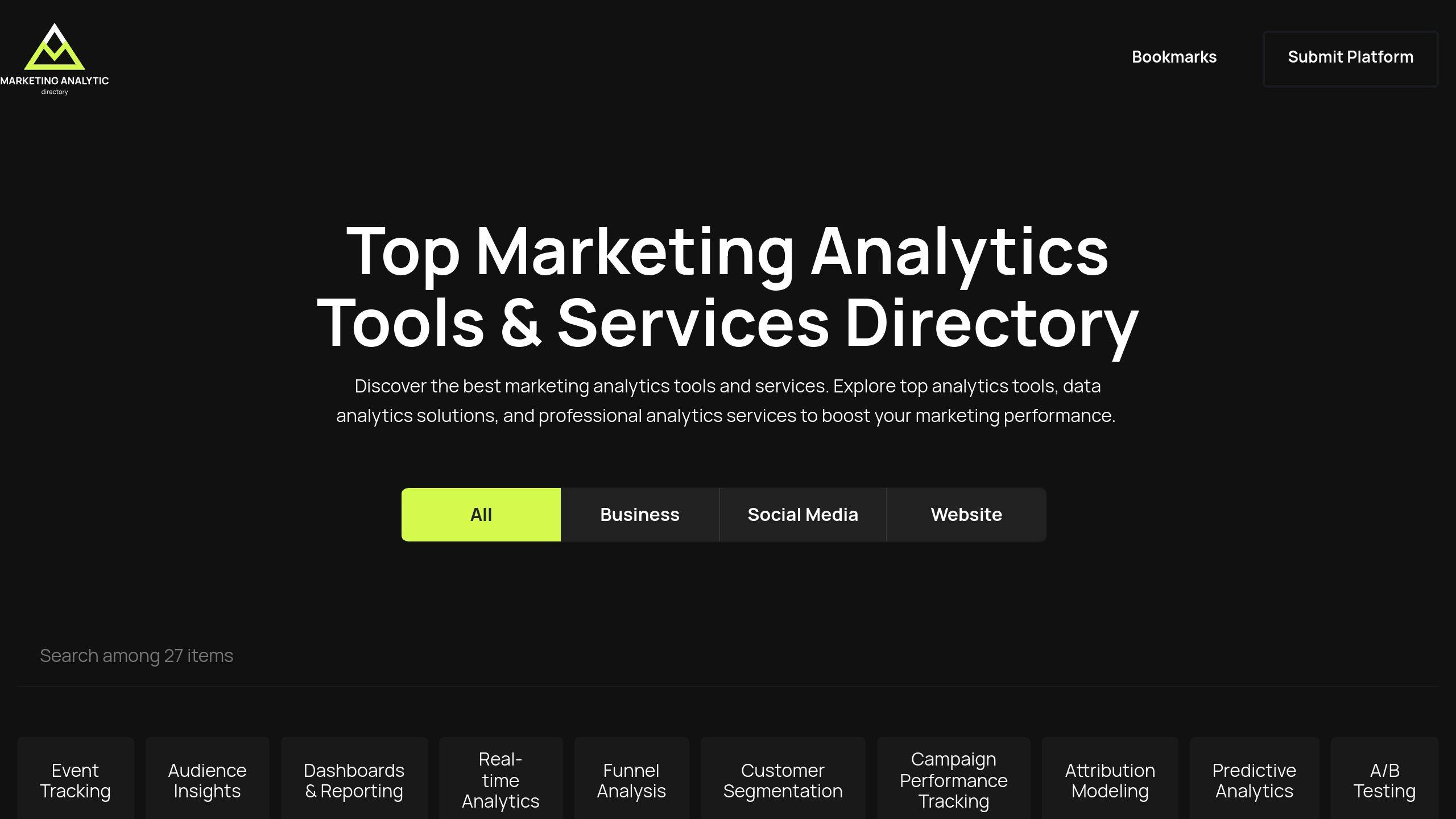Data silos are a common challenge in marketing, causing disconnected teams, incomplete customer profiles, and inconsistent messaging across channels. Breaking them down is essential for creating a unified customer view and improving cross-channel strategies. Here's how you can address this issue:
- Identify Silos: Look for conflicting metrics, duplicate records, and restricted data access.
- Resolve Silos: Implement data governance policies, centralize systems, and encourage team collaboration.
- Unify Data: Use tools like Customer Data Platforms (CDPs) and integration methods like ETL (Extract, Transform, Load).
- Choose the Right Tools: Evaluate options for scalability, usability, and integration using resources like the Marketing Analytics Tools Directory.
Identifying and Tackling Data Silos
Signs of Data Silos
Data silos in cross-channel marketing can show up in a few clear ways: inconsistent metrics, duplicate records, and restricted data access. These issues can severely disrupt marketing strategies [1][4].
| Data Silo Indicator | Impact on Marketing |
|---|---|
| Conflicting Metrics and Analytics | Leads to inconsistent reports and fragmented insights |
| Duplicate Records | Creates multiple, confusing customer profiles |
| Limited Data Access | Prevents teams from accessing cross-channel data |
For instance, if your email and social media teams report different conversion rates for the same campaign, it’s a sign that systems aren’t communicating. Similarly, having multiple versions of customer profiles in various databases can cause confusion and inefficiencies.
Spotting these red flags is a crucial first step. The real challenge lies in addressing them with the right strategies.
Methods to Address Data Silos
Resolving data silos involves tackling both the technical and organizational barriers that create them [2][4].
- Enforce Data Governance Policies: Establish clear guidelines for how data is collected, stored, and accessed. This ensures consistency and improves data quality across the organization [2].
- Centralize Systems: Use tools like identity graphs to bring customer data together. Centralized systems make it easier to execute cohesive campaigns across channels [4].
- Encourage Team Collaboration: Organizational silos are just as problematic as technical ones. Create cross-functional marketing teams, set shared goals, and hold regular meetings to encourage data sharing.
- Leverage Integration Tools: Tools designed for data consolidation and real-time synchronization can simplify unifying data. Check resources like the Marketing Analytics Tools Directory for options [2][4].
How to find the right marketing platform & avoid data silos
Data Integration and Unification Techniques
Once you've identified silos, the next step is bringing your data together using effective integration methods.
Data Integration Approaches
Centralizing marketing data through data warehousing allows for analysis across multiple channels. A key process in this is ETL (Extract, Transform, Load), which works as follows:
| ETL Phase | Purpose |
|---|---|
| Extract | Gather data from various sources into one place |
| Transform | Standardize data formats for consistency across channels |
| Load | Move the processed data into a system for unified analysis |
API-based integration is another option, enabling real-time data syncing between platforms for instant cross-channel insights.
Building a Unified Customer View
To create a single, accurate view of each customer:
- Gather and remove duplicate data from all sources.
- Assign unique IDs to match and unify customer profiles.
Tools for Data Integration and Unification
Customer Data Platforms (CDPs) play a major role here. They collect, standardize, and activate customer data across all channels [1][4].
CRMs complement CDPs by offering features like:
| Feature | Benefit |
|---|---|
| Real-time Data Visibility | Lets businesses respond instantly to customer actions |
| Cross-channel Tracking | Shows the complete customer journey in one place |
| Automated Data Cleansing | Ensures data stays accurate and reliable |
For help choosing the right tools, the Marketing Analytics Tools Directory provides detailed comparisons of data integration platforms. Picking the right solution can streamline your marketing efforts and simplify cross-channel data management.
sbb-itb-5174ba0
Using the Marketing Analytics Tools Directory

Overview of the Directory
The Marketing Analytics Tools Directory organizes tools based on their features, such as real-time analytics, campaign tracking, data integration, and business intelligence. These categories are crucial for tackling data silos and enabling better cross-channel segmentation. This resource is designed to help marketers find solutions that close data gaps and bring together customer insights from multiple channels.
Selecting Tools with the Directory
To make the most of the directory and address data silo issues, follow these steps:
-
Define Your Needs
Start by analyzing your current data challenges. Think about:
- How many data sources you manage
- How frequently data needs syncing
- The volume of data involved
- Budget constraints
-
Evaluate and Compare Options
When reviewing tools in the directory, keep these factors in mind:
- Whether they integrate well with your existing systems
- If they can scale as your data needs grow
- How simple they are to set up and use
- The quality of support and maintenance provided
The directory’s structure makes it easier to pinpoint tools that help resolve data silos while enhancing cross-channel segmentation. By using this resource, businesses can find the right solutions to unify their data and improve their marketing efforts across channels.
Conclusion: Key Points and Next Steps
Key Points Summary
Breaking down data silos allows for better cross-channel segmentation and a unified customer experience. Here are the main advantages:
- Consistent and accurate data across all platforms
- Improved collaboration among teams
- Easier and faster campaign management
- Deeper understanding of customer behavior
- Decisions grounded in data insights
These outcomes highlight why addressing data silos is so important. The steps below can help you move forward with unifying your data.
Next Steps
Ready to take action? Here's how to start implementing what you've learned:
-
Audit Your Data Infrastructure
- Review your systems for any gaps, duplicate entries, or disconnected data.
- Map out how data flows between your channels and teams. [2]
- Develop an Integration Plan
-
Select the Right Tools
Use the Marketing Analytics Tools Directory to evaluate tools based on key factors:
Factor What to Look For Integration Compatibility with systems Scalability Ability to grow with needs Usability Ease of implementation Support Available help and services -
Establish Data Governance
Put policies in place for:
- Maintaining data quality and standards
- Setting access controls
- Regular updates and maintenance
- Meeting compliance requirements [4]
The Marketing Analytics Tools Directory is a great resource to help you through these steps, making it easier to integrate data across your marketing channels effectively.
FAQs
How to get rid of data silos?
Breaking down data silos is essential for gaining a clear view of your customers and delivering consistent messaging across all platforms. Here’s how you can tackle this challenge:
Organizational Strategies
- Encourage collaboration between departments to improve information sharing.
- Build cross-functional teams with shared objectives.
- Set up clear communication channels to avoid confusion.
- Use controlled data access protocols, such as:
- Setting permissions for who can access what.
- Establishing usage guidelines.
- Implementing security measures.
- Conducting regular audits to ensure compliance.
Data Centralization
Create a unified system to store and manage your data. This includes:
- Centralizing data storage for easier access and analysis.
- Standardizing data formats and definitions to avoid inconsistencies.
- Running validation checks and verification processes.
- Performing regular quality controls to maintain data accuracy.
Integration Implementation
To integrate data effectively, it’s crucial to choose the right methods and tools. Key steps include:
- Selecting an integration approach that fits your needs.
- Ensuring all systems work well together.
- Keeping data quality intact during the process.
- Monitoring and updating systems regularly to avoid issues.
For instance, Stirista relies on a single source of truth (SSOT) to ensure their marketing decisions are based on accurate, unified data. This approach minimizes discrepancies and strengthens their cross-channel strategies [4].


